Organizational Behavior Report: Primark - Culture, Motivation, Teams
VerifiedAdded on 2023/01/12
|15
|4667
|1
Report
AI Summary
This report provides an in-depth analysis of organizational behavior within Primark, a prominent Irish fashion retailer. It examines how organizational culture, including power dynamics and political influences, impacts individual and team performance, referencing Handy's model for cultural analysis. The report delves into motivation theories, contrasting content theories (Maslow's hierarchy) and process theories (Adams' equity theory) and their application within Primark. Furthermore, it differentiates between effective and ineffective teams, emphasizing the importance of team management for achieving business objectives. The report also explores various concepts and philosophies of organizational behavior, providing a comprehensive overview of Primark's approach to managing its workforce and operational activities. The report underscores the significance of rewards, equitable treatment, and employee empowerment in fostering a positive and productive work environment. It also highlights the importance of innovation and employee recognition in the fashion industry.
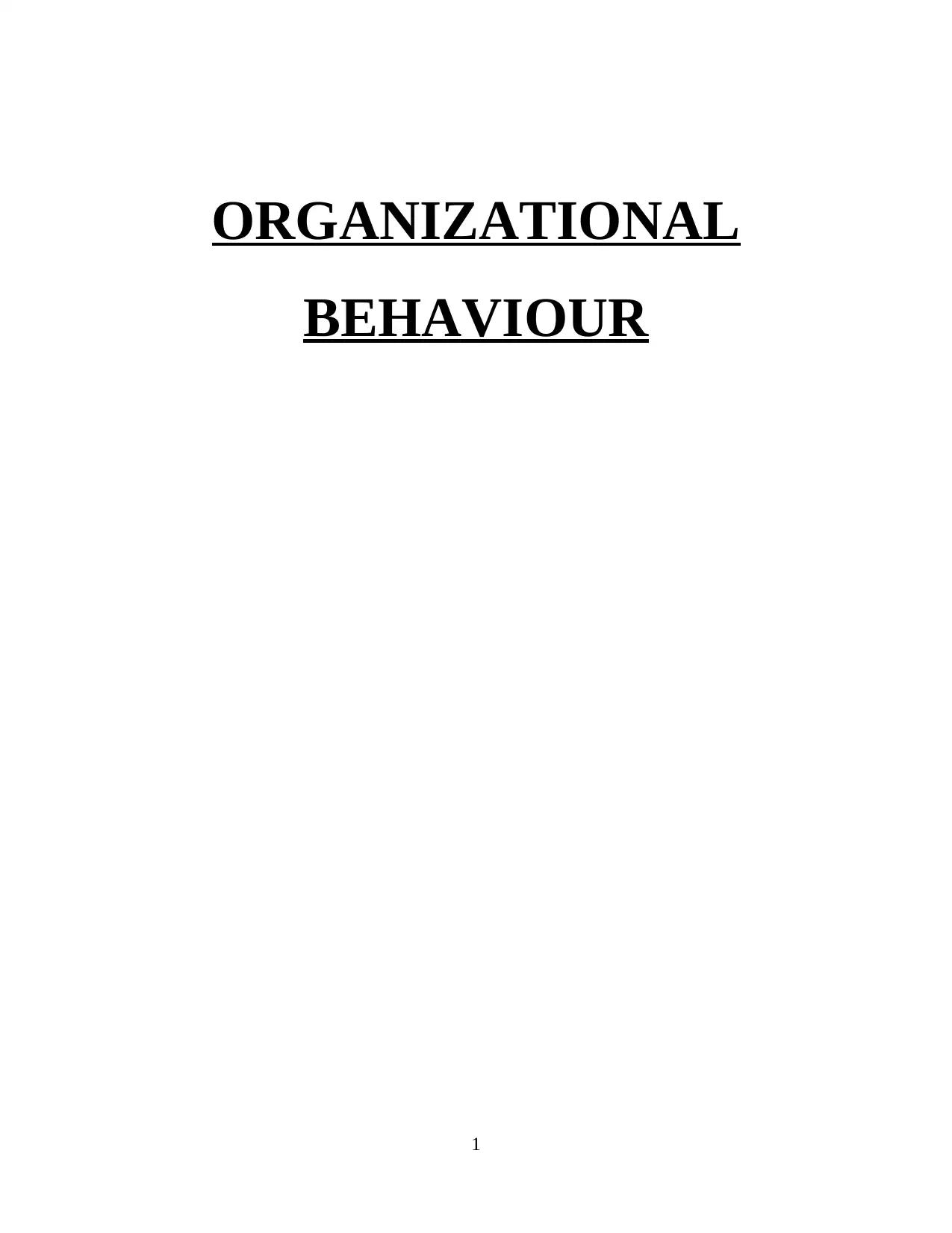
ORGANIZATIONAL
BEHAVIOUR
1
BEHAVIOUR
1
Paraphrase This Document
Need a fresh take? Get an instant paraphrase of this document with our AI Paraphraser
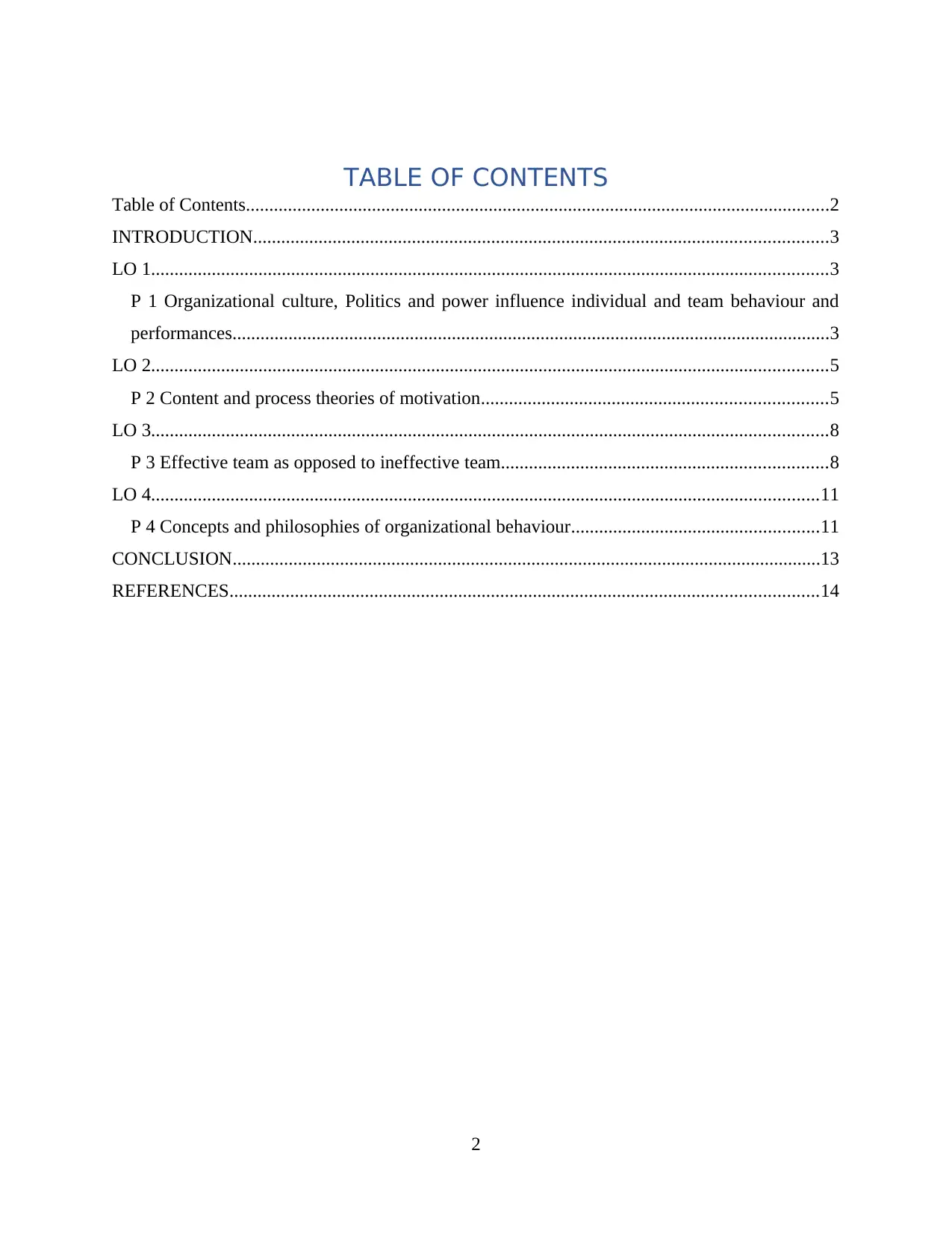
TABLE OF CONTENTS
Table of Contents.............................................................................................................................2
INTRODUCTION...........................................................................................................................3
LO 1.................................................................................................................................................3
P 1 Organizational culture, Politics and power influence individual and team behaviour and
performances................................................................................................................................3
LO 2.................................................................................................................................................5
P 2 Content and process theories of motivation..........................................................................5
LO 3.................................................................................................................................................8
P 3 Effective team as opposed to ineffective team......................................................................8
LO 4...............................................................................................................................................11
P 4 Concepts and philosophies of organizational behaviour.....................................................11
CONCLUSION..............................................................................................................................13
REFERENCES..............................................................................................................................14
2
Table of Contents.............................................................................................................................2
INTRODUCTION...........................................................................................................................3
LO 1.................................................................................................................................................3
P 1 Organizational culture, Politics and power influence individual and team behaviour and
performances................................................................................................................................3
LO 2.................................................................................................................................................5
P 2 Content and process theories of motivation..........................................................................5
LO 3.................................................................................................................................................8
P 3 Effective team as opposed to ineffective team......................................................................8
LO 4...............................................................................................................................................11
P 4 Concepts and philosophies of organizational behaviour.....................................................11
CONCLUSION..............................................................................................................................13
REFERENCES..............................................................................................................................14
2
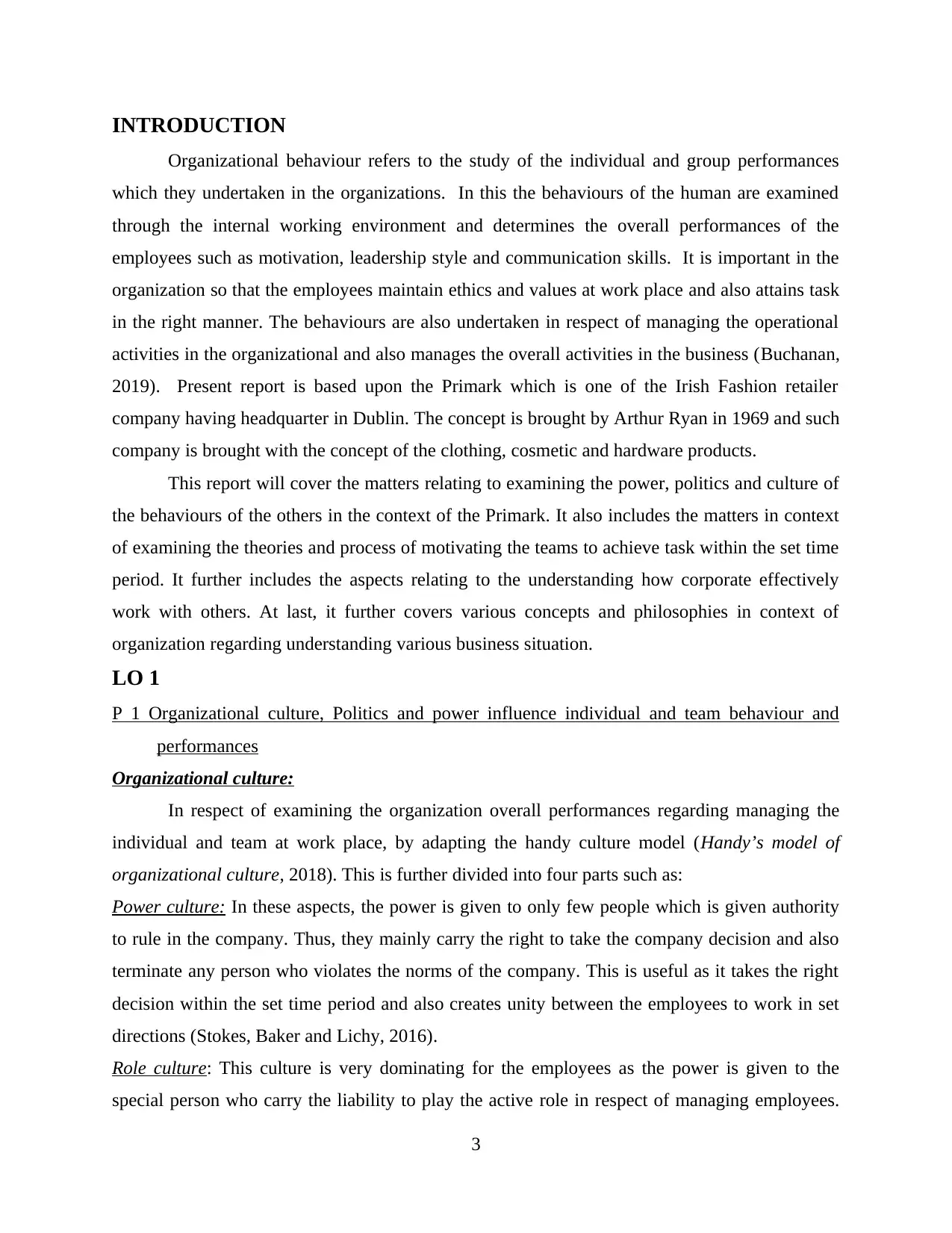
INTRODUCTION
Organizational behaviour refers to the study of the individual and group performances
which they undertaken in the organizations. In this the behaviours of the human are examined
through the internal working environment and determines the overall performances of the
employees such as motivation, leadership style and communication skills. It is important in the
organization so that the employees maintain ethics and values at work place and also attains task
in the right manner. The behaviours are also undertaken in respect of managing the operational
activities in the organizational and also manages the overall activities in the business (Buchanan,
2019). Present report is based upon the Primark which is one of the Irish Fashion retailer
company having headquarter in Dublin. The concept is brought by Arthur Ryan in 1969 and such
company is brought with the concept of the clothing, cosmetic and hardware products.
This report will cover the matters relating to examining the power, politics and culture of
the behaviours of the others in the context of the Primark. It also includes the matters in context
of examining the theories and process of motivating the teams to achieve task within the set time
period. It further includes the aspects relating to the understanding how corporate effectively
work with others. At last, it further covers various concepts and philosophies in context of
organization regarding understanding various business situation.
LO 1
P 1 Organizational culture, Politics and power influence individual and team behaviour and
performances
Organizational culture:
In respect of examining the organization overall performances regarding managing the
individual and team at work place, by adapting the handy culture model (Handy’s model of
organizational culture, 2018). This is further divided into four parts such as:
Power culture: In these aspects, the power is given to only few people which is given authority
to rule in the company. Thus, they mainly carry the right to take the company decision and also
terminate any person who violates the norms of the company. This is useful as it takes the right
decision within the set time period and also creates unity between the employees to work in set
directions (Stokes, Baker and Lichy, 2016).
Role culture: This culture is very dominating for the employees as the power is given to the
special person who carry the liability to play the active role in respect of managing employees.
3
Organizational behaviour refers to the study of the individual and group performances
which they undertaken in the organizations. In this the behaviours of the human are examined
through the internal working environment and determines the overall performances of the
employees such as motivation, leadership style and communication skills. It is important in the
organization so that the employees maintain ethics and values at work place and also attains task
in the right manner. The behaviours are also undertaken in respect of managing the operational
activities in the organizational and also manages the overall activities in the business (Buchanan,
2019). Present report is based upon the Primark which is one of the Irish Fashion retailer
company having headquarter in Dublin. The concept is brought by Arthur Ryan in 1969 and such
company is brought with the concept of the clothing, cosmetic and hardware products.
This report will cover the matters relating to examining the power, politics and culture of
the behaviours of the others in the context of the Primark. It also includes the matters in context
of examining the theories and process of motivating the teams to achieve task within the set time
period. It further includes the aspects relating to the understanding how corporate effectively
work with others. At last, it further covers various concepts and philosophies in context of
organization regarding understanding various business situation.
LO 1
P 1 Organizational culture, Politics and power influence individual and team behaviour and
performances
Organizational culture:
In respect of examining the organization overall performances regarding managing the
individual and team at work place, by adapting the handy culture model (Handy’s model of
organizational culture, 2018). This is further divided into four parts such as:
Power culture: In these aspects, the power is given to only few people which is given authority
to rule in the company. Thus, they mainly carry the right to take the company decision and also
terminate any person who violates the norms of the company. This is useful as it takes the right
decision within the set time period and also creates unity between the employees to work in set
directions (Stokes, Baker and Lichy, 2016).
Role culture: This culture is very dominating for the employees as the power is given to the
special person who carry the liability to play the active role in respect of managing employees.
3
⊘ This is a preview!⊘
Do you want full access?
Subscribe today to unlock all pages.

Trusted by 1+ million students worldwide
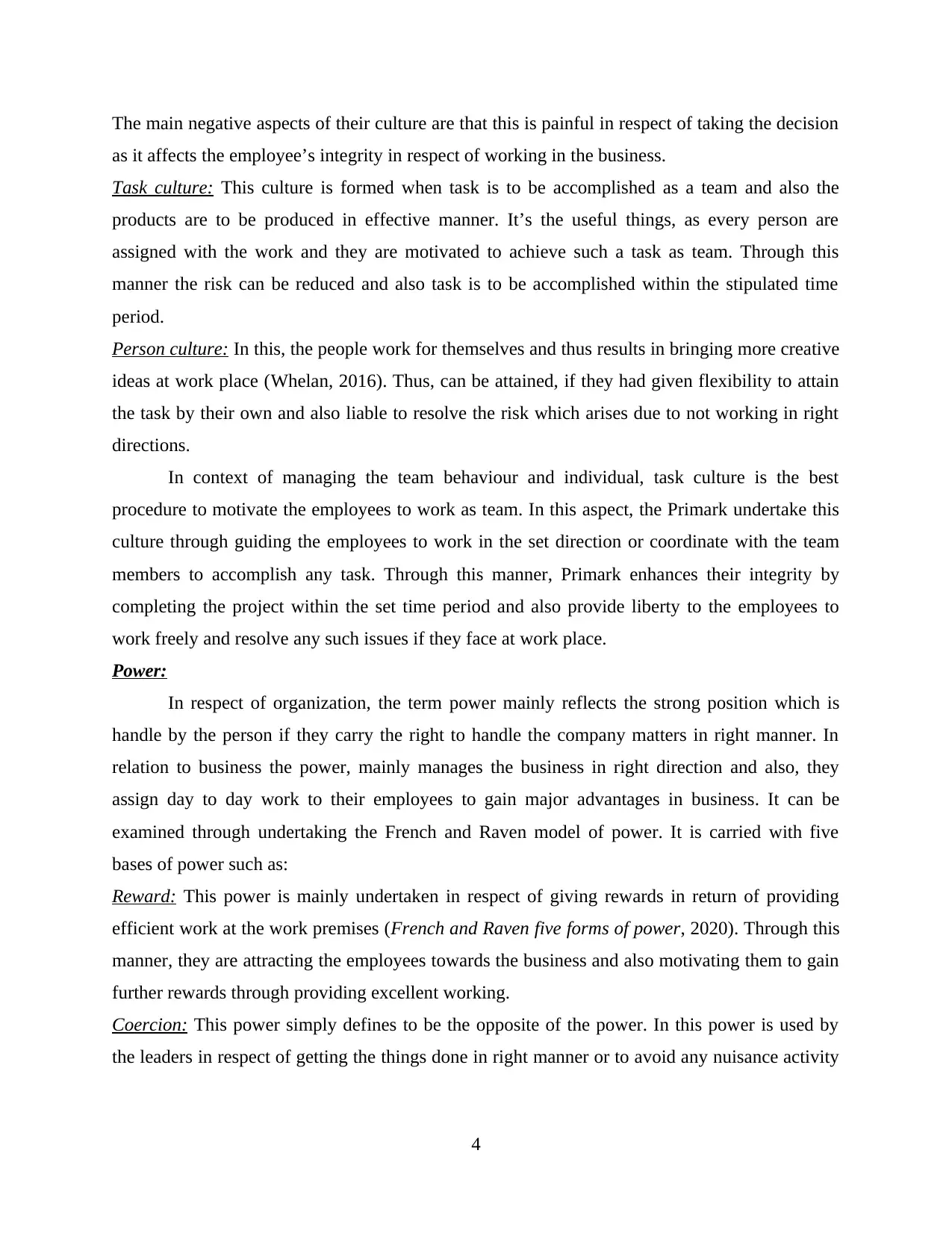
The main negative aspects of their culture are that this is painful in respect of taking the decision
as it affects the employee’s integrity in respect of working in the business.
Task culture: This culture is formed when task is to be accomplished as a team and also the
products are to be produced in effective manner. It’s the useful things, as every person are
assigned with the work and they are motivated to achieve such a task as team. Through this
manner the risk can be reduced and also task is to be accomplished within the stipulated time
period.
Person culture: In this, the people work for themselves and thus results in bringing more creative
ideas at work place (Whelan, 2016). Thus, can be attained, if they had given flexibility to attain
the task by their own and also liable to resolve the risk which arises due to not working in right
directions.
In context of managing the team behaviour and individual, task culture is the best
procedure to motivate the employees to work as team. In this aspect, the Primark undertake this
culture through guiding the employees to work in the set direction or coordinate with the team
members to accomplish any task. Through this manner, Primark enhances their integrity by
completing the project within the set time period and also provide liberty to the employees to
work freely and resolve any such issues if they face at work place.
Power:
In respect of organization, the term power mainly reflects the strong position which is
handle by the person if they carry the right to handle the company matters in right manner. In
relation to business the power, mainly manages the business in right direction and also, they
assign day to day work to their employees to gain major advantages in business. It can be
examined through undertaking the French and Raven model of power. It is carried with five
bases of power such as:
Reward: This power is mainly undertaken in respect of giving rewards in return of providing
efficient work at the work premises (French and Raven five forms of power, 2020). Through this
manner, they are attracting the employees towards the business and also motivating them to gain
further rewards through providing excellent working.
Coercion: This power simply defines to be the opposite of the power. In this power is used by
the leaders in respect of getting the things done in right manner or to avoid any nuisance activity
4
as it affects the employee’s integrity in respect of working in the business.
Task culture: This culture is formed when task is to be accomplished as a team and also the
products are to be produced in effective manner. It’s the useful things, as every person are
assigned with the work and they are motivated to achieve such a task as team. Through this
manner the risk can be reduced and also task is to be accomplished within the stipulated time
period.
Person culture: In this, the people work for themselves and thus results in bringing more creative
ideas at work place (Whelan, 2016). Thus, can be attained, if they had given flexibility to attain
the task by their own and also liable to resolve the risk which arises due to not working in right
directions.
In context of managing the team behaviour and individual, task culture is the best
procedure to motivate the employees to work as team. In this aspect, the Primark undertake this
culture through guiding the employees to work in the set direction or coordinate with the team
members to accomplish any task. Through this manner, Primark enhances their integrity by
completing the project within the set time period and also provide liberty to the employees to
work freely and resolve any such issues if they face at work place.
Power:
In respect of organization, the term power mainly reflects the strong position which is
handle by the person if they carry the right to handle the company matters in right manner. In
relation to business the power, mainly manages the business in right direction and also, they
assign day to day work to their employees to gain major advantages in business. It can be
examined through undertaking the French and Raven model of power. It is carried with five
bases of power such as:
Reward: This power is mainly undertaken in respect of giving rewards in return of providing
efficient work at the work premises (French and Raven five forms of power, 2020). Through this
manner, they are attracting the employees towards the business and also motivating them to gain
further rewards through providing excellent working.
Coercion: This power simply defines to be the opposite of the power. In this power is used by
the leaders in respect of getting the things done in right manner or to avoid any nuisance activity
4
Paraphrase This Document
Need a fresh take? Get an instant paraphrase of this document with our AI Paraphraser
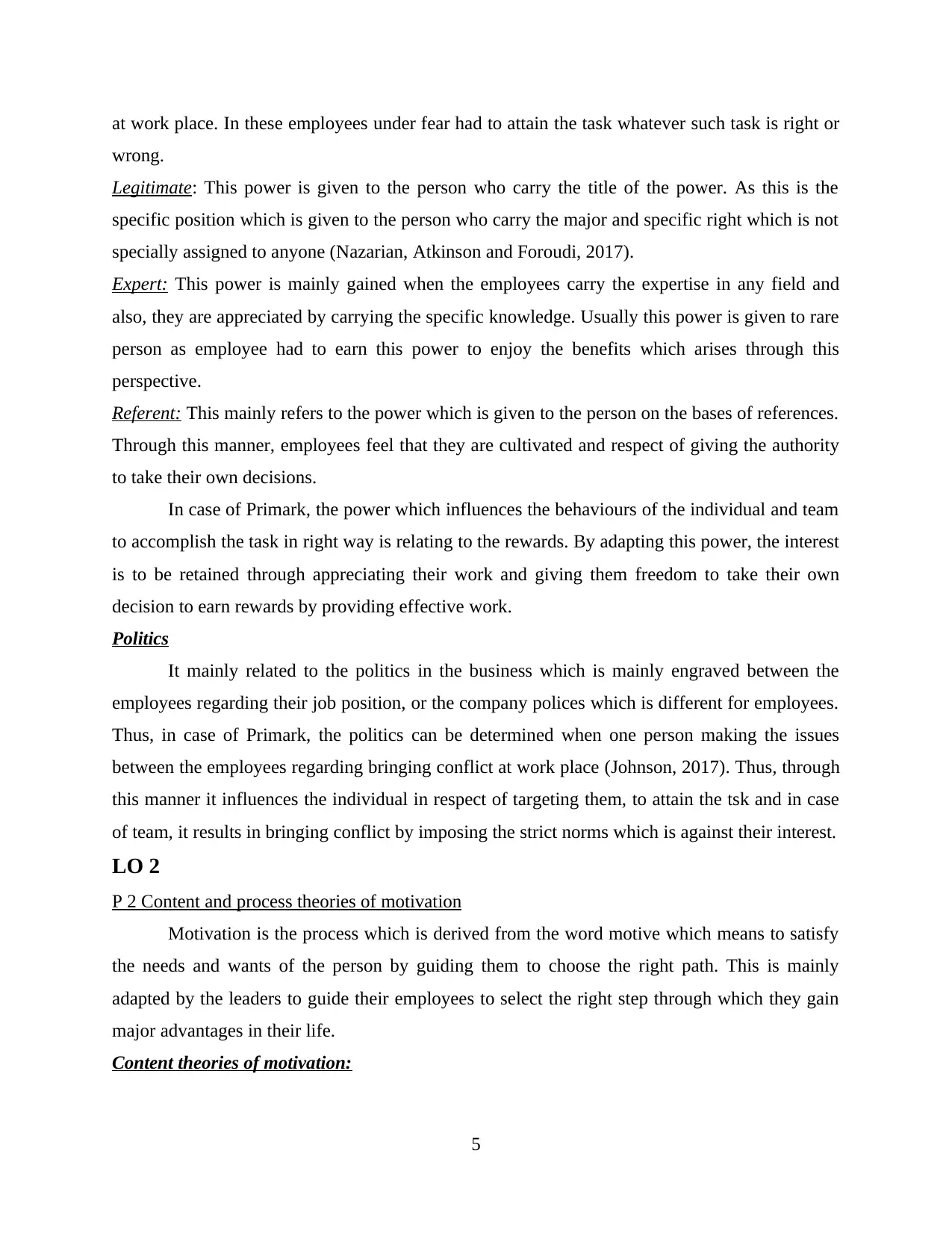
at work place. In these employees under fear had to attain the task whatever such task is right or
wrong.
Legitimate: This power is given to the person who carry the title of the power. As this is the
specific position which is given to the person who carry the major and specific right which is not
specially assigned to anyone (Nazarian, Atkinson and Foroudi, 2017).
Expert: This power is mainly gained when the employees carry the expertise in any field and
also, they are appreciated by carrying the specific knowledge. Usually this power is given to rare
person as employee had to earn this power to enjoy the benefits which arises through this
perspective.
Referent: This mainly refers to the power which is given to the person on the bases of references.
Through this manner, employees feel that they are cultivated and respect of giving the authority
to take their own decisions.
In case of Primark, the power which influences the behaviours of the individual and team
to accomplish the task in right way is relating to the rewards. By adapting this power, the interest
is to be retained through appreciating their work and giving them freedom to take their own
decision to earn rewards by providing effective work.
Politics
It mainly related to the politics in the business which is mainly engraved between the
employees regarding their job position, or the company polices which is different for employees.
Thus, in case of Primark, the politics can be determined when one person making the issues
between the employees regarding bringing conflict at work place (Johnson, 2017). Thus, through
this manner it influences the individual in respect of targeting them, to attain the tsk and in case
of team, it results in bringing conflict by imposing the strict norms which is against their interest.
LO 2
P 2 Content and process theories of motivation
Motivation is the process which is derived from the word motive which means to satisfy
the needs and wants of the person by guiding them to choose the right path. This is mainly
adapted by the leaders to guide their employees to select the right step through which they gain
major advantages in their life.
Content theories of motivation:
5
wrong.
Legitimate: This power is given to the person who carry the title of the power. As this is the
specific position which is given to the person who carry the major and specific right which is not
specially assigned to anyone (Nazarian, Atkinson and Foroudi, 2017).
Expert: This power is mainly gained when the employees carry the expertise in any field and
also, they are appreciated by carrying the specific knowledge. Usually this power is given to rare
person as employee had to earn this power to enjoy the benefits which arises through this
perspective.
Referent: This mainly refers to the power which is given to the person on the bases of references.
Through this manner, employees feel that they are cultivated and respect of giving the authority
to take their own decisions.
In case of Primark, the power which influences the behaviours of the individual and team
to accomplish the task in right way is relating to the rewards. By adapting this power, the interest
is to be retained through appreciating their work and giving them freedom to take their own
decision to earn rewards by providing effective work.
Politics
It mainly related to the politics in the business which is mainly engraved between the
employees regarding their job position, or the company polices which is different for employees.
Thus, in case of Primark, the politics can be determined when one person making the issues
between the employees regarding bringing conflict at work place (Johnson, 2017). Thus, through
this manner it influences the individual in respect of targeting them, to attain the tsk and in case
of team, it results in bringing conflict by imposing the strict norms which is against their interest.
LO 2
P 2 Content and process theories of motivation
Motivation is the process which is derived from the word motive which means to satisfy
the needs and wants of the person by guiding them to choose the right path. This is mainly
adapted by the leaders to guide their employees to select the right step through which they gain
major advantages in their life.
Content theories of motivation:
5
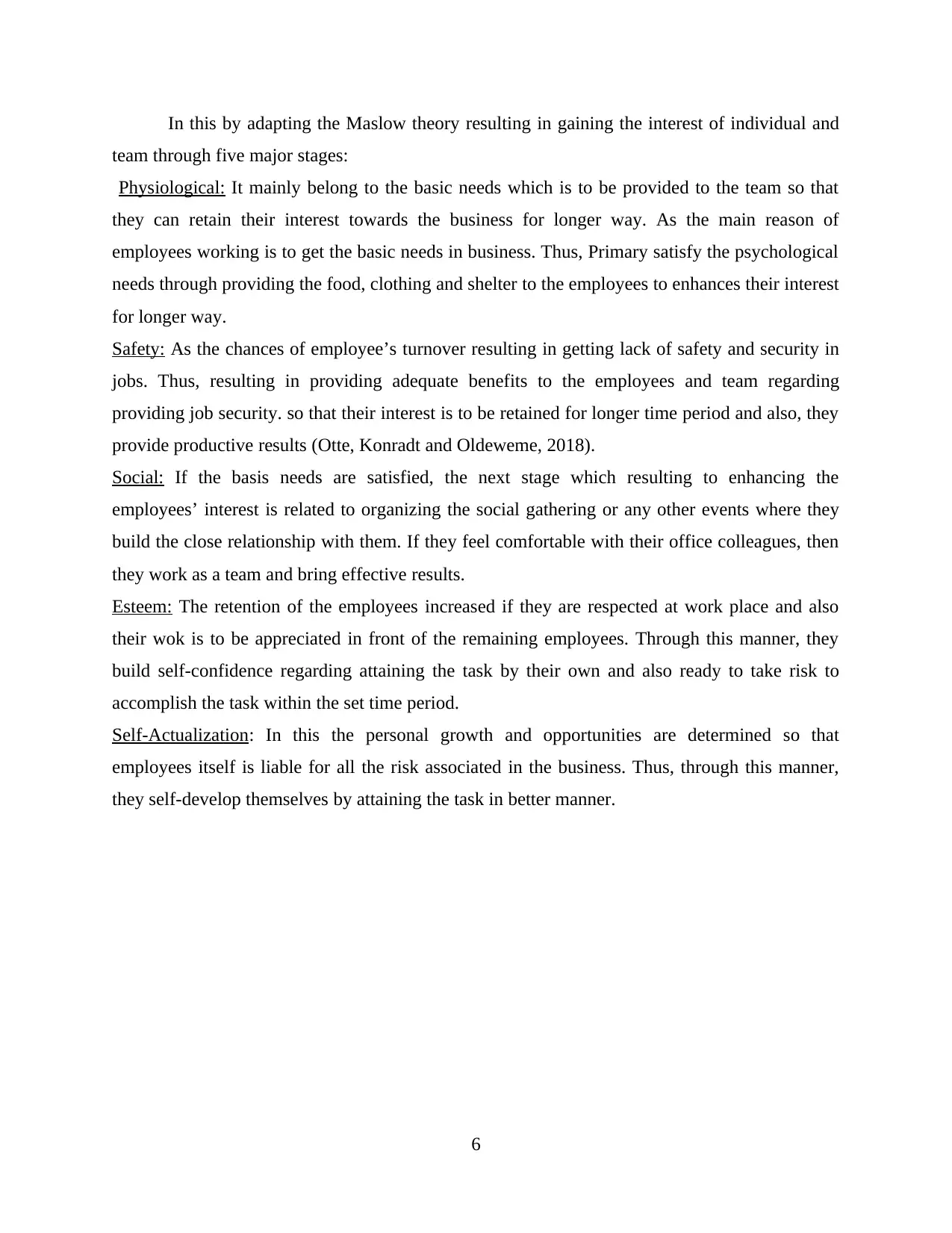
In this by adapting the Maslow theory resulting in gaining the interest of individual and
team through five major stages:
Physiological: It mainly belong to the basic needs which is to be provided to the team so that
they can retain their interest towards the business for longer way. As the main reason of
employees working is to get the basic needs in business. Thus, Primary satisfy the psychological
needs through providing the food, clothing and shelter to the employees to enhances their interest
for longer way.
Safety: As the chances of employee’s turnover resulting in getting lack of safety and security in
jobs. Thus, resulting in providing adequate benefits to the employees and team regarding
providing job security. so that their interest is to be retained for longer time period and also, they
provide productive results (Otte, Konradt and Oldeweme, 2018).
Social: If the basis needs are satisfied, the next stage which resulting to enhancing the
employees’ interest is related to organizing the social gathering or any other events where they
build the close relationship with them. If they feel comfortable with their office colleagues, then
they work as a team and bring effective results.
Esteem: The retention of the employees increased if they are respected at work place and also
their wok is to be appreciated in front of the remaining employees. Through this manner, they
build self-confidence regarding attaining the task by their own and also ready to take risk to
accomplish the task within the set time period.
Self-Actualization: In this the personal growth and opportunities are determined so that
employees itself is liable for all the risk associated in the business. Thus, through this manner,
they self-develop themselves by attaining the task in better manner.
6
team through five major stages:
Physiological: It mainly belong to the basic needs which is to be provided to the team so that
they can retain their interest towards the business for longer way. As the main reason of
employees working is to get the basic needs in business. Thus, Primary satisfy the psychological
needs through providing the food, clothing and shelter to the employees to enhances their interest
for longer way.
Safety: As the chances of employee’s turnover resulting in getting lack of safety and security in
jobs. Thus, resulting in providing adequate benefits to the employees and team regarding
providing job security. so that their interest is to be retained for longer time period and also, they
provide productive results (Otte, Konradt and Oldeweme, 2018).
Social: If the basis needs are satisfied, the next stage which resulting to enhancing the
employees’ interest is related to organizing the social gathering or any other events where they
build the close relationship with them. If they feel comfortable with their office colleagues, then
they work as a team and bring effective results.
Esteem: The retention of the employees increased if they are respected at work place and also
their wok is to be appreciated in front of the remaining employees. Through this manner, they
build self-confidence regarding attaining the task by their own and also ready to take risk to
accomplish the task within the set time period.
Self-Actualization: In this the personal growth and opportunities are determined so that
employees itself is liable for all the risk associated in the business. Thus, through this manner,
they self-develop themselves by attaining the task in better manner.
6
⊘ This is a preview!⊘
Do you want full access?
Subscribe today to unlock all pages.

Trusted by 1+ million students worldwide
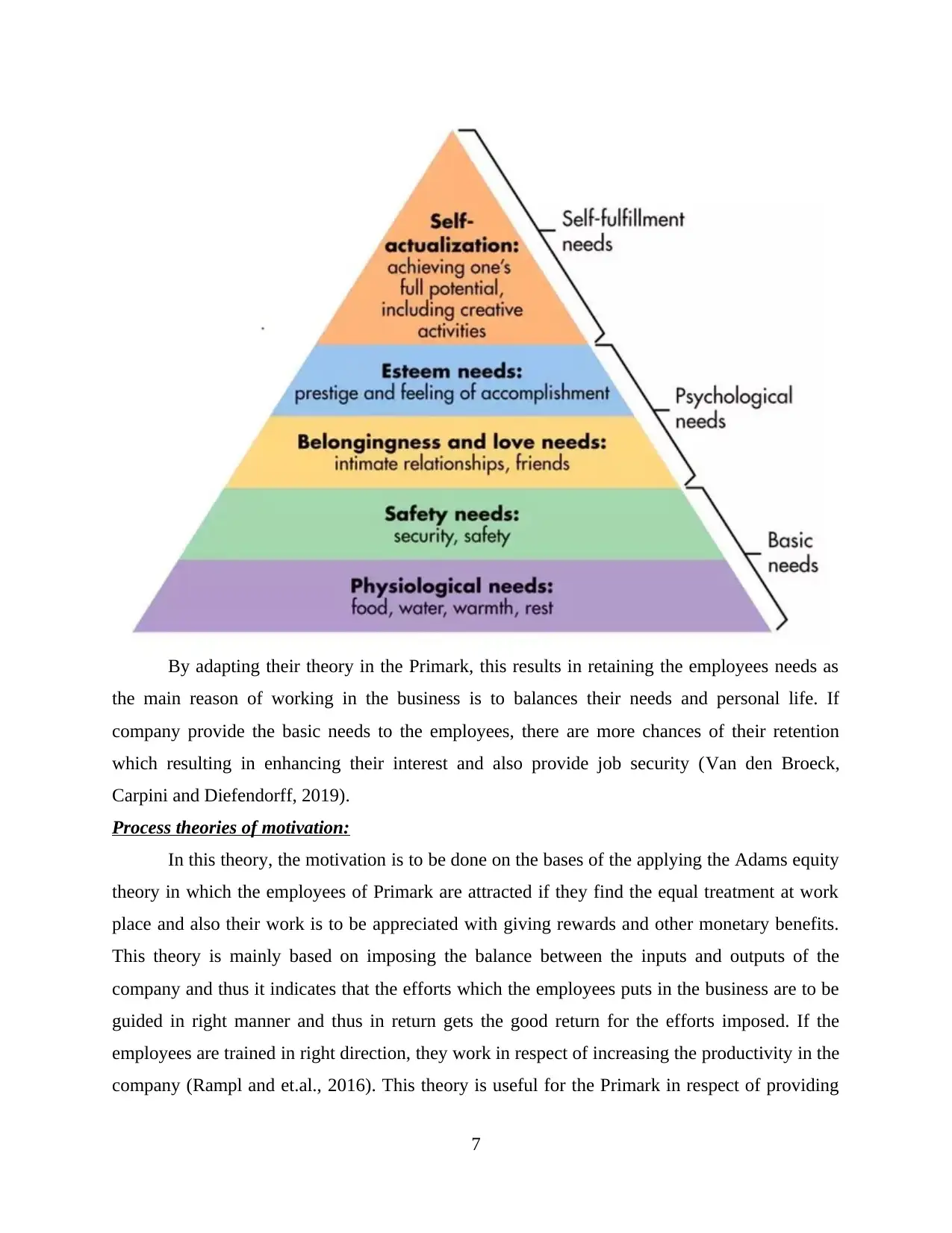
By adapting their theory in the Primark, this results in retaining the employees needs as
the main reason of working in the business is to balances their needs and personal life. If
company provide the basic needs to the employees, there are more chances of their retention
which resulting in enhancing their interest and also provide job security (Van den Broeck,
Carpini and Diefendorff, 2019).
Process theories of motivation:
In this theory, the motivation is to be done on the bases of the applying the Adams equity
theory in which the employees of Primark are attracted if they find the equal treatment at work
place and also their work is to be appreciated with giving rewards and other monetary benefits.
This theory is mainly based on imposing the balance between the inputs and outputs of the
company and thus it indicates that the efforts which the employees puts in the business are to be
guided in right manner and thus in return gets the good return for the efforts imposed. If the
employees are trained in right direction, they work in respect of increasing the productivity in the
company (Rampl and et.al., 2016). This theory is useful for the Primark in respect of providing
7
the main reason of working in the business is to balances their needs and personal life. If
company provide the basic needs to the employees, there are more chances of their retention
which resulting in enhancing their interest and also provide job security (Van den Broeck,
Carpini and Diefendorff, 2019).
Process theories of motivation:
In this theory, the motivation is to be done on the bases of the applying the Adams equity
theory in which the employees of Primark are attracted if they find the equal treatment at work
place and also their work is to be appreciated with giving rewards and other monetary benefits.
This theory is mainly based on imposing the balance between the inputs and outputs of the
company and thus it indicates that the efforts which the employees puts in the business are to be
guided in right manner and thus in return gets the good return for the efforts imposed. If the
employees are trained in right direction, they work in respect of increasing the productivity in the
company (Rampl and et.al., 2016). This theory is useful for the Primark in respect of providing
7
Paraphrase This Document
Need a fresh take? Get an instant paraphrase of this document with our AI Paraphraser
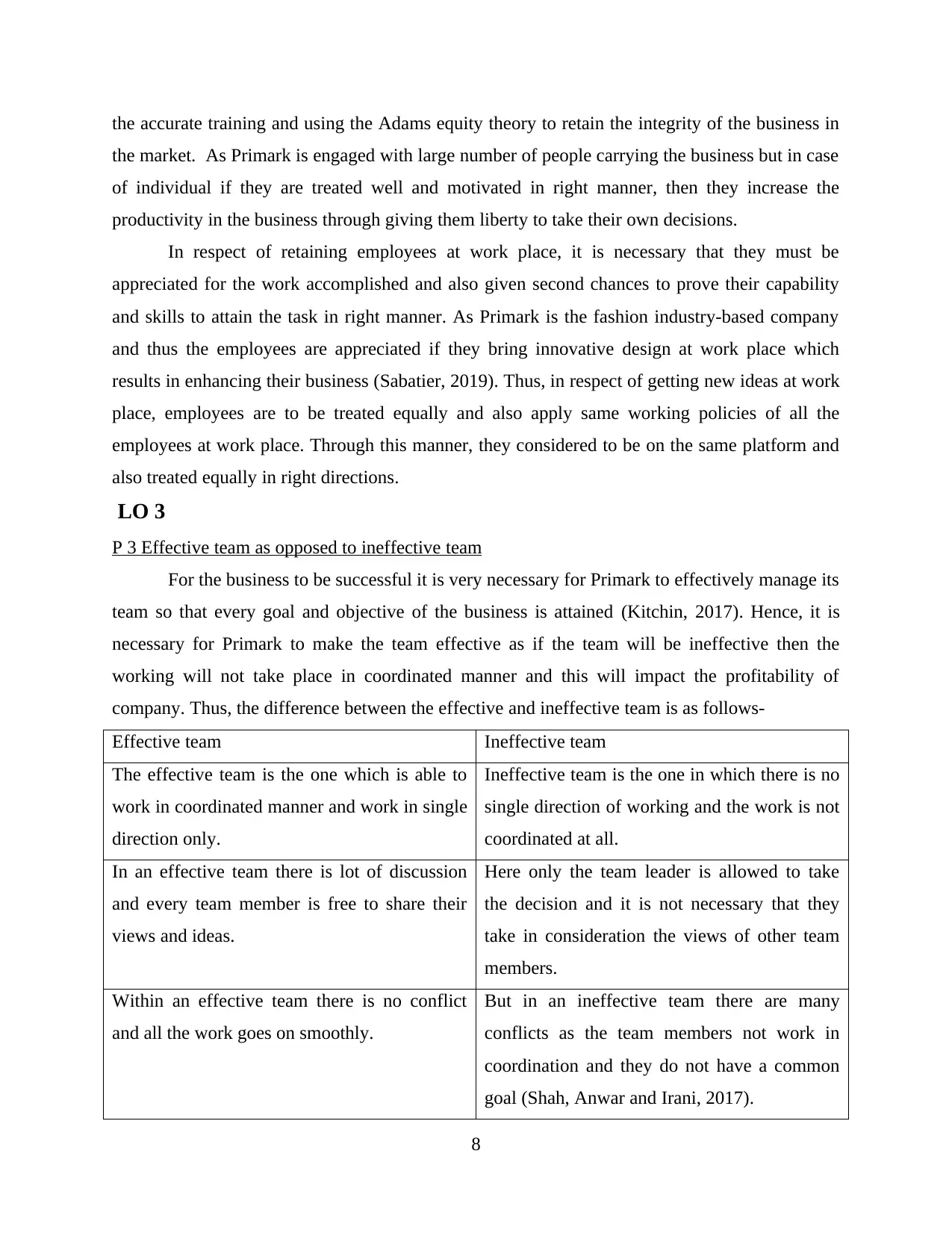
the accurate training and using the Adams equity theory to retain the integrity of the business in
the market. As Primark is engaged with large number of people carrying the business but in case
of individual if they are treated well and motivated in right manner, then they increase the
productivity in the business through giving them liberty to take their own decisions.
In respect of retaining employees at work place, it is necessary that they must be
appreciated for the work accomplished and also given second chances to prove their capability
and skills to attain the task in right manner. As Primark is the fashion industry-based company
and thus the employees are appreciated if they bring innovative design at work place which
results in enhancing their business (Sabatier, 2019). Thus, in respect of getting new ideas at work
place, employees are to be treated equally and also apply same working policies of all the
employees at work place. Through this manner, they considered to be on the same platform and
also treated equally in right directions.
LO 3
P 3 Effective team as opposed to ineffective team
For the business to be successful it is very necessary for Primark to effectively manage its
team so that every goal and objective of the business is attained (Kitchin, 2017). Hence, it is
necessary for Primark to make the team effective as if the team will be ineffective then the
working will not take place in coordinated manner and this will impact the profitability of
company. Thus, the difference between the effective and ineffective team is as follows-
Effective team Ineffective team
The effective team is the one which is able to
work in coordinated manner and work in single
direction only.
Ineffective team is the one in which there is no
single direction of working and the work is not
coordinated at all.
In an effective team there is lot of discussion
and every team member is free to share their
views and ideas.
Here only the team leader is allowed to take
the decision and it is not necessary that they
take in consideration the views of other team
members.
Within an effective team there is no conflict
and all the work goes on smoothly.
But in an ineffective team there are many
conflicts as the team members not work in
coordination and they do not have a common
goal (Shah, Anwar and Irani, 2017).
8
the market. As Primark is engaged with large number of people carrying the business but in case
of individual if they are treated well and motivated in right manner, then they increase the
productivity in the business through giving them liberty to take their own decisions.
In respect of retaining employees at work place, it is necessary that they must be
appreciated for the work accomplished and also given second chances to prove their capability
and skills to attain the task in right manner. As Primark is the fashion industry-based company
and thus the employees are appreciated if they bring innovative design at work place which
results in enhancing their business (Sabatier, 2019). Thus, in respect of getting new ideas at work
place, employees are to be treated equally and also apply same working policies of all the
employees at work place. Through this manner, they considered to be on the same platform and
also treated equally in right directions.
LO 3
P 3 Effective team as opposed to ineffective team
For the business to be successful it is very necessary for Primark to effectively manage its
team so that every goal and objective of the business is attained (Kitchin, 2017). Hence, it is
necessary for Primark to make the team effective as if the team will be ineffective then the
working will not take place in coordinated manner and this will impact the profitability of
company. Thus, the difference between the effective and ineffective team is as follows-
Effective team Ineffective team
The effective team is the one which is able to
work in coordinated manner and work in single
direction only.
Ineffective team is the one in which there is no
single direction of working and the work is not
coordinated at all.
In an effective team there is lot of discussion
and every team member is free to share their
views and ideas.
Here only the team leader is allowed to take
the decision and it is not necessary that they
take in consideration the views of other team
members.
Within an effective team there is no conflict
and all the work goes on smoothly.
But in an ineffective team there are many
conflicts as the team members not work in
coordination and they do not have a common
goal (Shah, Anwar and Irani, 2017).
8
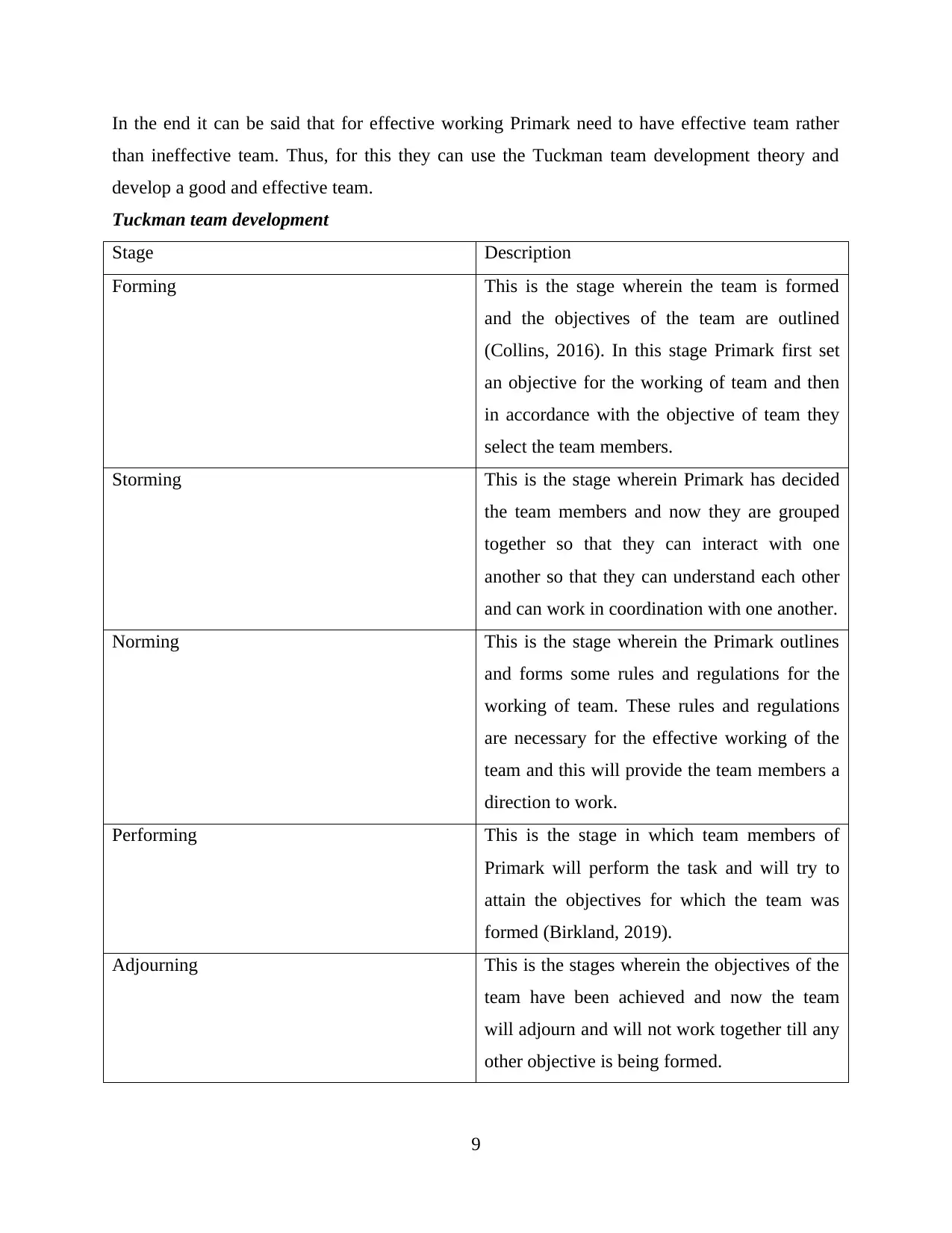
In the end it can be said that for effective working Primark need to have effective team rather
than ineffective team. Thus, for this they can use the Tuckman team development theory and
develop a good and effective team.
Tuckman team development
Stage Description
Forming This is the stage wherein the team is formed
and the objectives of the team are outlined
(Collins, 2016). In this stage Primark first set
an objective for the working of team and then
in accordance with the objective of team they
select the team members.
Storming This is the stage wherein Primark has decided
the team members and now they are grouped
together so that they can interact with one
another so that they can understand each other
and can work in coordination with one another.
Norming This is the stage wherein the Primark outlines
and forms some rules and regulations for the
working of team. These rules and regulations
are necessary for the effective working of the
team and this will provide the team members a
direction to work.
Performing This is the stage in which team members of
Primark will perform the task and will try to
attain the objectives for which the team was
formed (Birkland, 2019).
Adjourning This is the stages wherein the objectives of the
team have been achieved and now the team
will adjourn and will not work together till any
other objective is being formed.
9
than ineffective team. Thus, for this they can use the Tuckman team development theory and
develop a good and effective team.
Tuckman team development
Stage Description
Forming This is the stage wherein the team is formed
and the objectives of the team are outlined
(Collins, 2016). In this stage Primark first set
an objective for the working of team and then
in accordance with the objective of team they
select the team members.
Storming This is the stage wherein Primark has decided
the team members and now they are grouped
together so that they can interact with one
another so that they can understand each other
and can work in coordination with one another.
Norming This is the stage wherein the Primark outlines
and forms some rules and regulations for the
working of team. These rules and regulations
are necessary for the effective working of the
team and this will provide the team members a
direction to work.
Performing This is the stage in which team members of
Primark will perform the task and will try to
attain the objectives for which the team was
formed (Birkland, 2019).
Adjourning This is the stages wherein the objectives of the
team have been achieved and now the team
will adjourn and will not work together till any
other objective is being formed.
9
⊘ This is a preview!⊘
Do you want full access?
Subscribe today to unlock all pages.

Trusted by 1+ million students worldwide
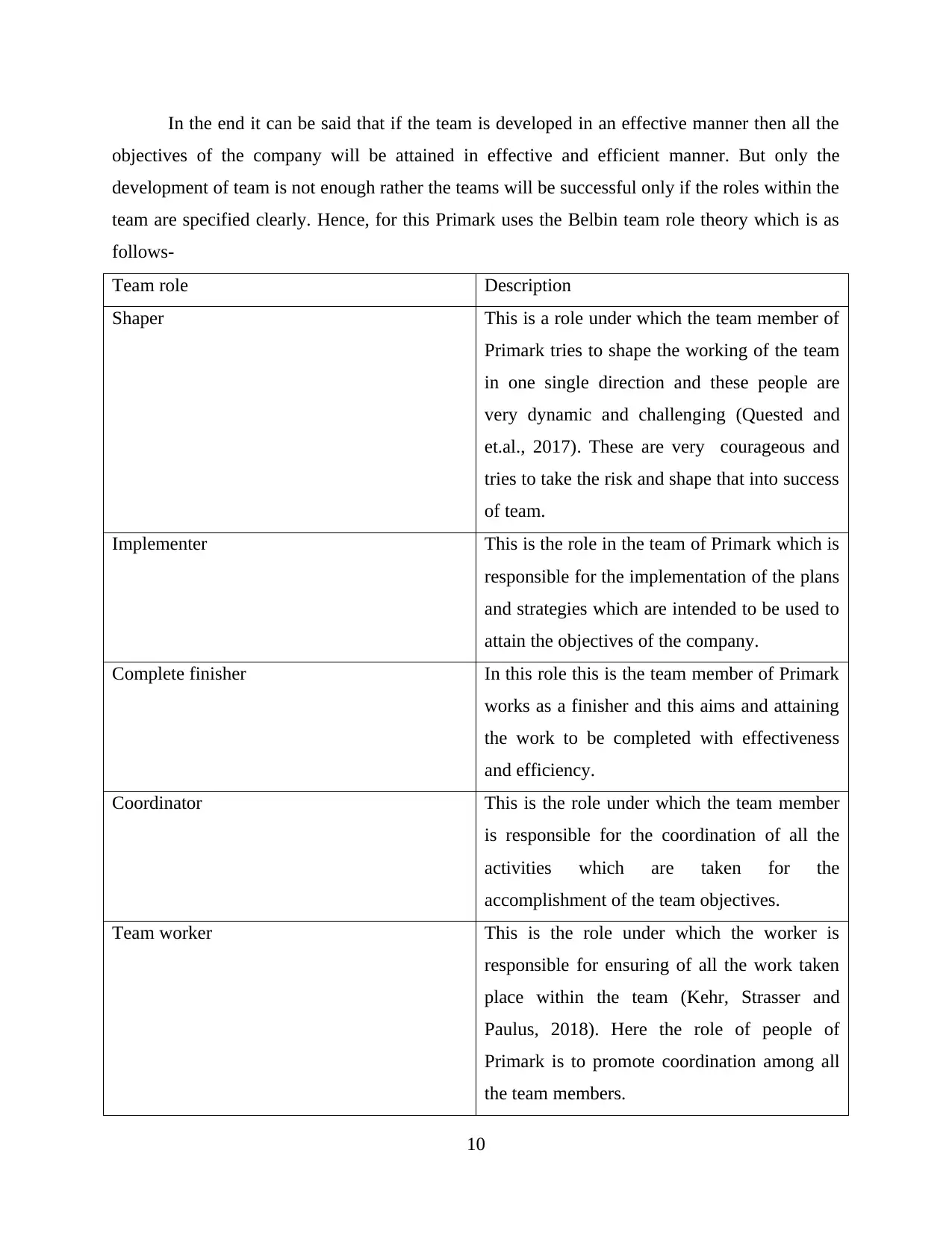
In the end it can be said that if the team is developed in an effective manner then all the
objectives of the company will be attained in effective and efficient manner. But only the
development of team is not enough rather the teams will be successful only if the roles within the
team are specified clearly. Hence, for this Primark uses the Belbin team role theory which is as
follows-
Team role Description
Shaper This is a role under which the team member of
Primark tries to shape the working of the team
in one single direction and these people are
very dynamic and challenging (Quested and
et.al., 2017). These are very courageous and
tries to take the risk and shape that into success
of team.
Implementer This is the role in the team of Primark which is
responsible for the implementation of the plans
and strategies which are intended to be used to
attain the objectives of the company.
Complete finisher In this role this is the team member of Primark
works as a finisher and this aims and attaining
the work to be completed with effectiveness
and efficiency.
Coordinator This is the role under which the team member
is responsible for the coordination of all the
activities which are taken for the
accomplishment of the team objectives.
Team worker This is the role under which the worker is
responsible for ensuring of all the work taken
place within the team (Kehr, Strasser and
Paulus, 2018). Here the role of people of
Primark is to promote coordination among all
the team members.
10
objectives of the company will be attained in effective and efficient manner. But only the
development of team is not enough rather the teams will be successful only if the roles within the
team are specified clearly. Hence, for this Primark uses the Belbin team role theory which is as
follows-
Team role Description
Shaper This is a role under which the team member of
Primark tries to shape the working of the team
in one single direction and these people are
very dynamic and challenging (Quested and
et.al., 2017). These are very courageous and
tries to take the risk and shape that into success
of team.
Implementer This is the role in the team of Primark which is
responsible for the implementation of the plans
and strategies which are intended to be used to
attain the objectives of the company.
Complete finisher In this role this is the team member of Primark
works as a finisher and this aims and attaining
the work to be completed with effectiveness
and efficiency.
Coordinator This is the role under which the team member
is responsible for the coordination of all the
activities which are taken for the
accomplishment of the team objectives.
Team worker This is the role under which the worker is
responsible for ensuring of all the work taken
place within the team (Kehr, Strasser and
Paulus, 2018). Here the role of people of
Primark is to promote coordination among all
the team members.
10
Paraphrase This Document
Need a fresh take? Get an instant paraphrase of this document with our AI Paraphraser
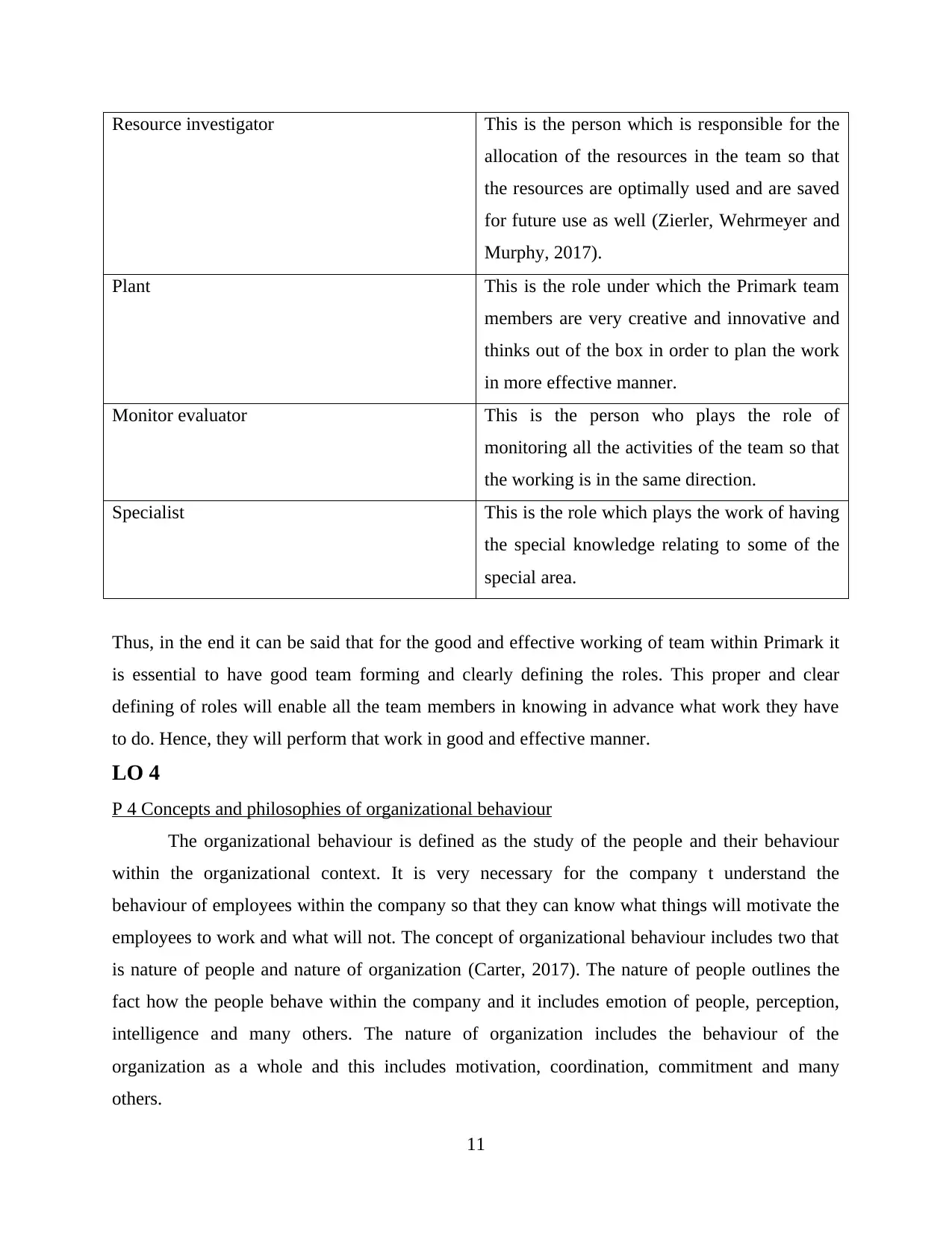
Resource investigator This is the person which is responsible for the
allocation of the resources in the team so that
the resources are optimally used and are saved
for future use as well (Zierler, Wehrmeyer and
Murphy, 2017).
Plant This is the role under which the Primark team
members are very creative and innovative and
thinks out of the box in order to plan the work
in more effective manner.
Monitor evaluator This is the person who plays the role of
monitoring all the activities of the team so that
the working is in the same direction.
Specialist This is the role which plays the work of having
the special knowledge relating to some of the
special area.
Thus, in the end it can be said that for the good and effective working of team within Primark it
is essential to have good team forming and clearly defining the roles. This proper and clear
defining of roles will enable all the team members in knowing in advance what work they have
to do. Hence, they will perform that work in good and effective manner.
LO 4
P 4 Concepts and philosophies of organizational behaviour
The organizational behaviour is defined as the study of the people and their behaviour
within the organizational context. It is very necessary for the company t understand the
behaviour of employees within the company so that they can know what things will motivate the
employees to work and what will not. The concept of organizational behaviour includes two that
is nature of people and nature of organization (Carter, 2017). The nature of people outlines the
fact how the people behave within the company and it includes emotion of people, perception,
intelligence and many others. The nature of organization includes the behaviour of the
organization as a whole and this includes motivation, coordination, commitment and many
others.
11
allocation of the resources in the team so that
the resources are optimally used and are saved
for future use as well (Zierler, Wehrmeyer and
Murphy, 2017).
Plant This is the role under which the Primark team
members are very creative and innovative and
thinks out of the box in order to plan the work
in more effective manner.
Monitor evaluator This is the person who plays the role of
monitoring all the activities of the team so that
the working is in the same direction.
Specialist This is the role which plays the work of having
the special knowledge relating to some of the
special area.
Thus, in the end it can be said that for the good and effective working of team within Primark it
is essential to have good team forming and clearly defining the roles. This proper and clear
defining of roles will enable all the team members in knowing in advance what work they have
to do. Hence, they will perform that work in good and effective manner.
LO 4
P 4 Concepts and philosophies of organizational behaviour
The organizational behaviour is defined as the study of the people and their behaviour
within the organizational context. It is very necessary for the company t understand the
behaviour of employees within the company so that they can know what things will motivate the
employees to work and what will not. The concept of organizational behaviour includes two that
is nature of people and nature of organization (Carter, 2017). The nature of people outlines the
fact how the people behave within the company and it includes emotion of people, perception,
intelligence and many others. The nature of organization includes the behaviour of the
organization as a whole and this includes motivation, coordination, commitment and many
others.
11
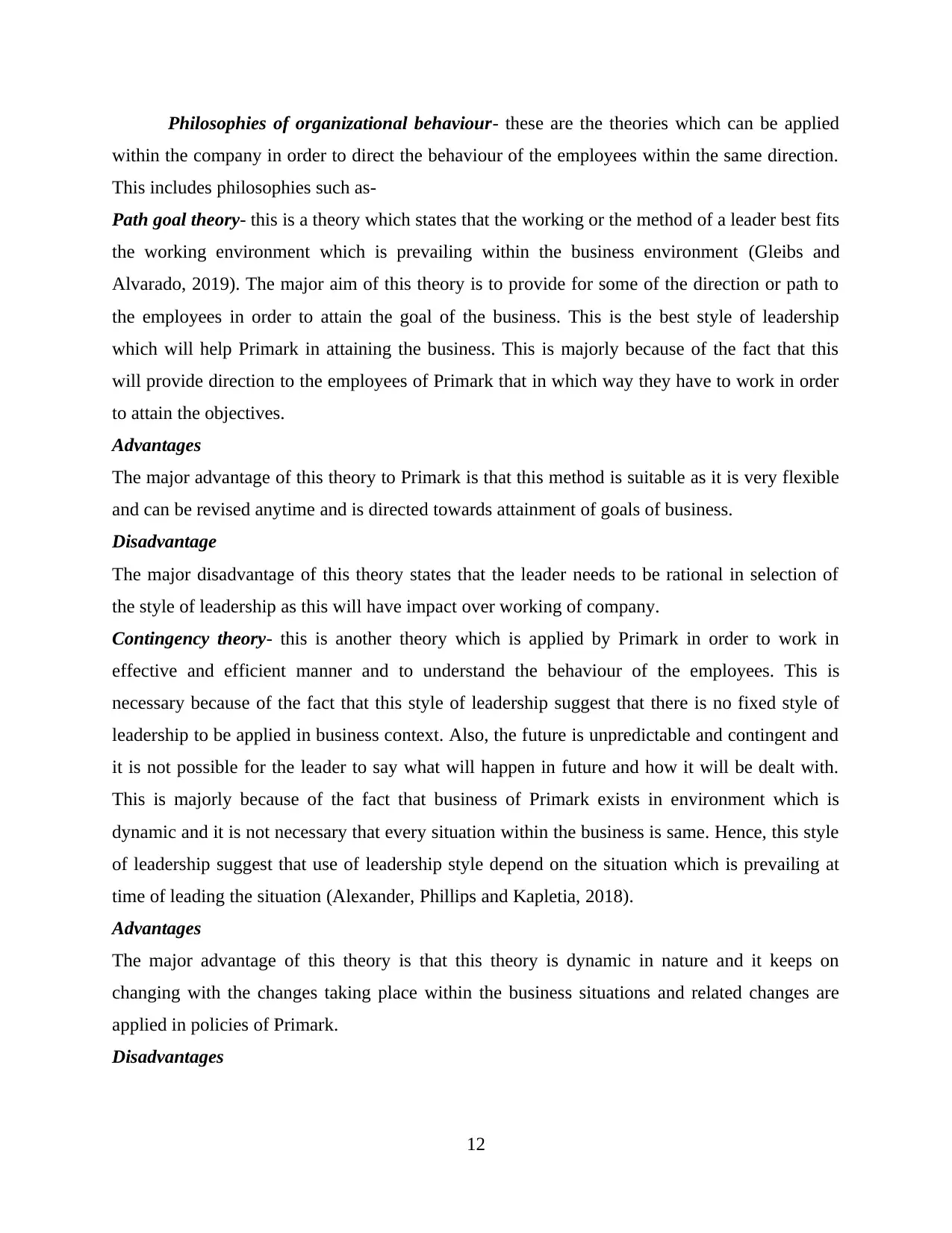
Philosophies of organizational behaviour- these are the theories which can be applied
within the company in order to direct the behaviour of the employees within the same direction.
This includes philosophies such as-
Path goal theory- this is a theory which states that the working or the method of a leader best fits
the working environment which is prevailing within the business environment (Gleibs and
Alvarado, 2019). The major aim of this theory is to provide for some of the direction or path to
the employees in order to attain the goal of the business. This is the best style of leadership
which will help Primark in attaining the business. This is majorly because of the fact that this
will provide direction to the employees of Primark that in which way they have to work in order
to attain the objectives.
Advantages
The major advantage of this theory to Primark is that this method is suitable as it is very flexible
and can be revised anytime and is directed towards attainment of goals of business.
Disadvantage
The major disadvantage of this theory states that the leader needs to be rational in selection of
the style of leadership as this will have impact over working of company.
Contingency theory- this is another theory which is applied by Primark in order to work in
effective and efficient manner and to understand the behaviour of the employees. This is
necessary because of the fact that this style of leadership suggest that there is no fixed style of
leadership to be applied in business context. Also, the future is unpredictable and contingent and
it is not possible for the leader to say what will happen in future and how it will be dealt with.
This is majorly because of the fact that business of Primark exists in environment which is
dynamic and it is not necessary that every situation within the business is same. Hence, this style
of leadership suggest that use of leadership style depend on the situation which is prevailing at
time of leading the situation (Alexander, Phillips and Kapletia, 2018).
Advantages
The major advantage of this theory is that this theory is dynamic in nature and it keeps on
changing with the changes taking place within the business situations and related changes are
applied in policies of Primark.
Disadvantages
12
within the company in order to direct the behaviour of the employees within the same direction.
This includes philosophies such as-
Path goal theory- this is a theory which states that the working or the method of a leader best fits
the working environment which is prevailing within the business environment (Gleibs and
Alvarado, 2019). The major aim of this theory is to provide for some of the direction or path to
the employees in order to attain the goal of the business. This is the best style of leadership
which will help Primark in attaining the business. This is majorly because of the fact that this
will provide direction to the employees of Primark that in which way they have to work in order
to attain the objectives.
Advantages
The major advantage of this theory to Primark is that this method is suitable as it is very flexible
and can be revised anytime and is directed towards attainment of goals of business.
Disadvantage
The major disadvantage of this theory states that the leader needs to be rational in selection of
the style of leadership as this will have impact over working of company.
Contingency theory- this is another theory which is applied by Primark in order to work in
effective and efficient manner and to understand the behaviour of the employees. This is
necessary because of the fact that this style of leadership suggest that there is no fixed style of
leadership to be applied in business context. Also, the future is unpredictable and contingent and
it is not possible for the leader to say what will happen in future and how it will be dealt with.
This is majorly because of the fact that business of Primark exists in environment which is
dynamic and it is not necessary that every situation within the business is same. Hence, this style
of leadership suggest that use of leadership style depend on the situation which is prevailing at
time of leading the situation (Alexander, Phillips and Kapletia, 2018).
Advantages
The major advantage of this theory is that this theory is dynamic in nature and it keeps on
changing with the changes taking place within the business situations and related changes are
applied in policies of Primark.
Disadvantages
12
⊘ This is a preview!⊘
Do you want full access?
Subscribe today to unlock all pages.

Trusted by 1+ million students worldwide
1 out of 15
Related Documents
Your All-in-One AI-Powered Toolkit for Academic Success.
+13062052269
info@desklib.com
Available 24*7 on WhatsApp / Email
![[object Object]](/_next/static/media/star-bottom.7253800d.svg)
Unlock your academic potential
Copyright © 2020–2025 A2Z Services. All Rights Reserved. Developed and managed by ZUCOL.





